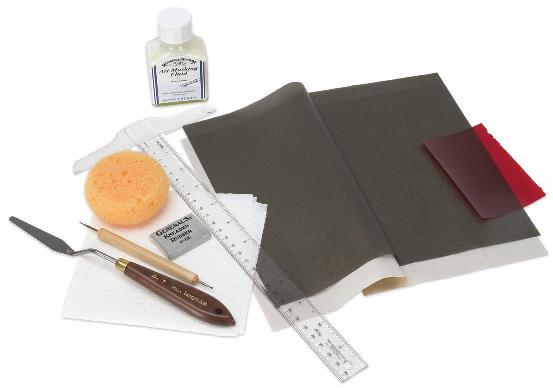MATERIALS
 Palette Knife: I do not like to use plastic palette knives. A good quality, flexible knife is an important painting tool. The three knives that I use that are available from Royal Brush are: P-16, good for mixing; K-4, for palette knife mountains and water lines; and P-5 for transferring paint from area to area, spattering edges and general painting.
Palette Knife: I do not like to use plastic palette knives. A good quality, flexible knife is an important painting tool. The three knives that I use that are available from Royal Brush are: P-16, good for mixing; K-4, for palette knife mountains and water lines; and P-5 for transferring paint from area to area, spattering edges and general painting.
 Stylus: Used to transfer patterns to any surface with the aid of transfer paper. I also use a stylus to etch into wet oil paint when needed see Transferring A Pattern. Look for a double-ended stylus. Check the ballpoints and look for a stylus that has a large and small point.
Stylus: Used to transfer patterns to any surface with the aid of transfer paper. I also use a stylus to etch into wet oil paint when needed see Transferring A Pattern. Look for a double-ended stylus. Check the ballpoints and look for a stylus that has a large and small point.
 Paper Towels: I prefer the blue shop towels available from many of the mass merchandisers. They are usually found in the automotive department. These are very absorbent and do not leave lint when wiping over a canvas or project piece. Whatever paper towel you choose, be sure it is soft and absorbent. Rough paper towels are like sandpaper to your brushes.
Paper Towels: I prefer the blue shop towels available from many of the mass merchandisers. They are usually found in the automotive department. These are very absorbent and do not leave lint when wiping over a canvas or project piece. Whatever paper towel you choose, be sure it is soft and absorbent. Rough paper towels are like sandpaper to your brushes.
 Round Synthetic Sponge: Used to make foliage, clouds and background trees. Be sure to wash it in clean water as soon as you are finished sponging. For small areas, I like to cut the sponge into halves or fourths.
Round Synthetic Sponge: Used to make foliage, clouds and background trees. Be sure to wash it in clean water as soon as you are finished sponging. For small areas, I like to cut the sponge into halves or fourths.
 Kneaded Eraser: Used to remove art masking fluid.
Kneaded Eraser: Used to remove art masking fluid.
 T-square: used to ensure straight vertical and horizontal lines, especially on buildings in landscape painting.
T-square: used to ensure straight vertical and horizontal lines, especially on buildings in landscape painting.
 Art Masking Fluid: Used to block an area of the canvas that you do not want to get paint into or where you want a background color to show through. Apply the fluid with an old brush and then remove it with a kneaded eraser when you have completed the painting around the masked-off area.
Art Masking Fluid: Used to block an area of the canvas that you do not want to get paint into or where you want a background color to show through. Apply the fluid with an old brush and then remove it with a kneaded eraser when you have completed the painting around the masked-off area.
 Graphite Paper: Also known as transfer paper and available in white, gray or black. This is used to transfer the traced pattern onto the painting surface.
Graphite Paper: Also known as transfer paper and available in white, gray or black. This is used to transfer the traced pattern onto the painting surface.
 Red Acetate: Used to check the values in a painting.it may be purchased in most art supply stores.
Red Acetate: Used to check the values in a painting.it may be purchased in most art supply stores.

 Palette Knife: I do not like to use plastic palette knives. A good quality, flexible knife is an important painting tool. The three knives that I use that are available from Royal Brush are: P-16, good for mixing; K-4, for palette knife mountains and water lines; and P-5 for transferring paint from area to area, spattering edges and general painting.
Palette Knife: I do not like to use plastic palette knives. A good quality, flexible knife is an important painting tool. The three knives that I use that are available from Royal Brush are: P-16, good for mixing; K-4, for palette knife mountains and water lines; and P-5 for transferring paint from area to area, spattering edges and general painting.